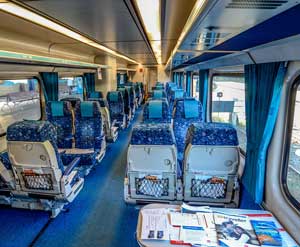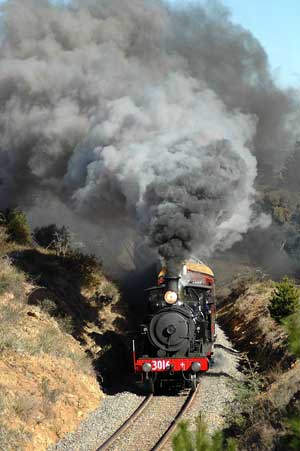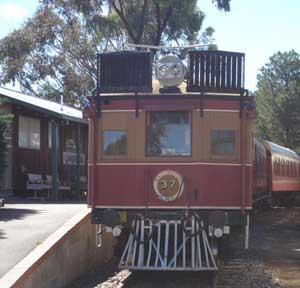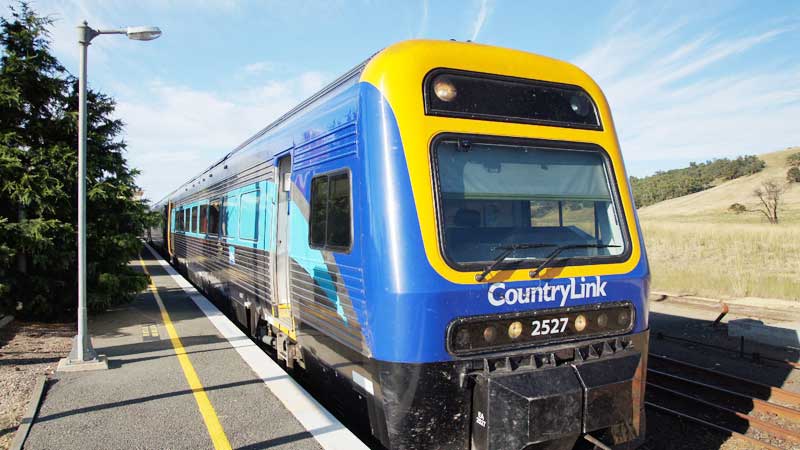
Explorer Rail Link
Canberra’s only rail link to the outside world is via the NSW Government’s TrainLink rail service. It is a daily service using modern Xplorer trains. Canberra has no suburban rail service.
The train departs Sydney Central Station and travels to Canberra via the Southern Highlands, Goulburn and Bungendore. The trip to Canberra Railway Station takes around four and a half hours. There are 2-3 services each way per day. Normally operated by a three carriage set but during times of high demand these can be built up to four.
Canberra is also served by NSW TrainLink road coach services to Cootamundra, Bombala and Eden. V/Line coach service to Bairnsdale also operates via the station.
Website >>
Canberra railway station is located in the Canberra suburb of Kingston. In March 1913 work began on a new 8.5 kilometre rail link from the capital to Queanbeyan on the Bombala line. The line was constructed, managed and operated by the New South Wales Public Works Department on behalf of the Federal Government. It came under the control of the Commonwealth Railways in 1927.
The station building opened on 21 April 1924. From 1927 when Federal Parliament moved to Canberra, the rail passenger service was upgraded with the introduction of a Canberra portion to the Cooma Mail overnight train to Sydney that connected with Melbourne sleeper trains at Goulburn.[1] A daylight service from Sydney was also introduced.
A new passenger terminal building opened in October 1966. Canberra station, along with the line to Queanbeyan, was owned and staffed by Australian National until May 1985 when it was transferred to the State Rail Authority which operated all the services on the line. Steam locomotive 1210 that had hauled the first train into Canberra in May 1914, was displayed on a plinth outside the station from January 1962 until September 1984, when it was moved to the Canberra Railway Museum and returned to service in 1988.
Canberra Railway Museum is run by the ACT division of the Australian Railway Historical Society (ARHS). The museum houses displays of historic locomotives, passenger cars, freight vehicles, track machinery and railway memorabilia. The museum precinct also serves as a base for the society’s rail operations. The Society preserves railway history, particularly that of Canberra and the southern districts of New South Wales, for the enjoyment and enlightenment of present and future generations. Members work toward this goal by: collecting and restoring locomotives, other rolling-stock and items of railway memorabilia; preserving and recording railway history; and operating trains with restored rolling-stock.
The Canberra Railway Museum is the home to Australia’s oldest operating steam locomotive, and one of the world’s oldest ‘mainline’ steam locomotives built in 1878, and also the heaviest, the 265 tonnes Beyer-Garratt steam locomotive. The Society also has three CPH railmotor units at Canberra Railway Museum (CPH 13, CPH 27 and CPH 37), and one other (CPH 2) on loan to another organisation. CPH 13 is destined to be transferred to the Oberon Tarana Heritage Railway.
The ARHS ACT division runs frequent tours year-round including trips on the Bungendore branch and many themed train such as a Santa’s Train, a Tulip time express and school holiday rail discovery events.
Website >>
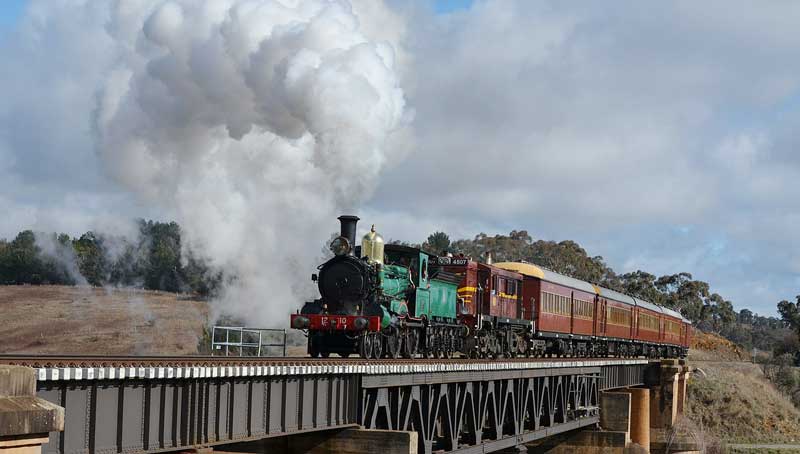
Walter Burley Griffin’s original Canberra plan included a railway to come to Canberra City, with stations on the north, east and south. Work started in December 1920, with the line opening on 15 June 1921. It branched off from the Queanbeyan to Canberra line at the Power House siding near Cunningham Street, heading north on a raised embankment through the Causeway, and across the Molonglo River. The bridges over Jerrabomberra Creek and Molonglo River were of low temporary standard. A siding was provided to the north of the river at Russell for the workers camp that was there. The line curved to the north west in Reid, behind St Johns Church and the TAFE. A platform for the railway was built in what is now Garema Place. Finally a line continued to the north to Eloura Street in Braddon where there was a marshalling yard.
The track was owned and maintained by the Commonwealth Railways with trains operated by the New South Wales Government Railways. In July 1922 a flood on the Molonglo River washed away the legs on the trestle bridge, leaving the bridge deck suspended by the rails and sagging into the water. The bridge was never reconstructed and the rails were removed in 1940.
A narrow gauge 1,067-millimetre line was built in 1923 from the Yarralumla brickworks to Old Parliament house. This passed along Adelaide Avenue, and round the north of State Circle. A branch went to the Hotel Canberra. The line continued to the Power House in Kingston. The brickworks tramway was extended to Civic. It crossed the Molonglo on a bridge near Scotts Crossing. The older 4-foot-8½-inch-wide (1.435 m) track was reduced to the 3 1 D2 feet (1.1 m) by shifting one rail. The tramway terminated at the Civic Centre Station. The tramway was dismantled on 9 May 1927 as a cleanup for the opening of parliament house.
The building of a railway between Canberra and Yass was specified in the Seat of Government Acceptance Act 1909, and plans were made to extend the existing Canberra line to Yass in 1924 and 1934. The proposal was last considered by the government in 1971, but was not considered to be economically justified.
During World War I plans were drawn up for a railway to the Tuggeranong Arsenal. The route ran from the Queanbeyan line via Macarthur, Fadden, Erindale, Wanniassa and Oxley to a station in north east Greenway. There was also to be a hospital near the Kambah Wool Shed, a small-arms factory near Pine Island, and a civic centre. The line was not constructed. A plan was also drawn for a Canberra to Jervis Bay line in 1914, to connect Canberra with what was to be its port. Little was heard of this project after 1921.







